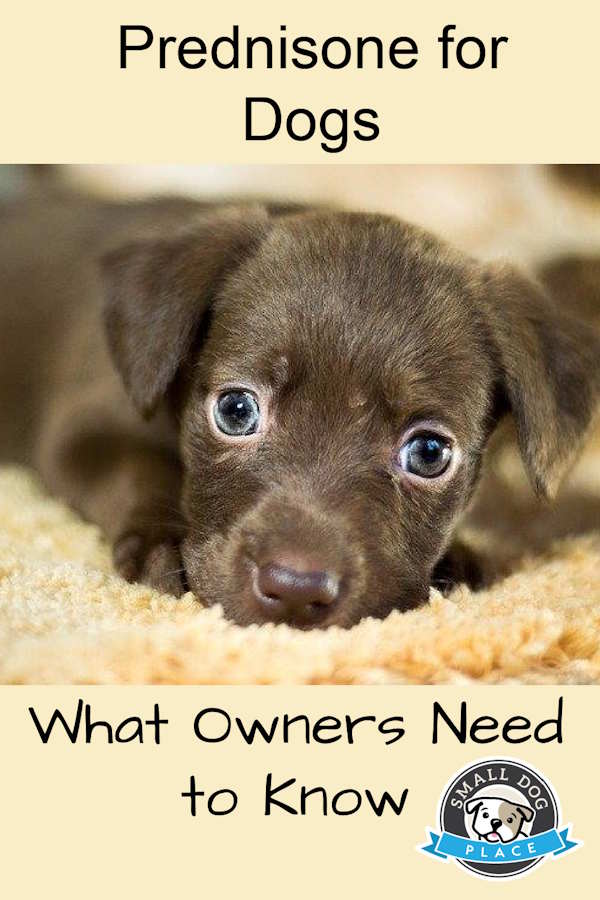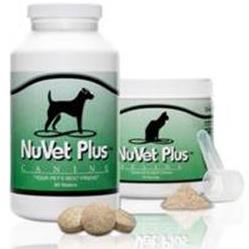- Small Dog Place Home
- Health
- Prednisone for Dogs
Prednisone for Dogs: Uses, Dosage, & Side Effects You Need To Know
Prednisone for Dogs
Prednisone is a synthetic corticosteroid commonly prescribed in veterinary medicine to treat various inflammatory and immune-mediated conditions in dogs.
It mimics the effects of cortisol, a natural hormone produced by the adrenal glands, helping to reduce inflammation and suppress overactive immune responses.
 Wondering about the possible side effects of prednisone for dogs?
Wondering about the possible side effects of prednisone for dogs?As a synthetic steroid, prednisone may result in side effects that may be serious, so it’s good to first consider if it’s really necessary to use prednisone on your dog. Let’s take a look at why this medication is not good for long-term use.
Common Uses of Prednisone in Dogs:
- Allergies: Alleviates symptoms such as itching, redness, and swelling associated with allergic reactions.
- Arthritis: Reduces joint inflammation and pain, improving mobility in dogs with osteoarthritis.
- Autoimmune Diseases: Manages conditions where the immune system attacks the body's own tissues, such as lupus.
- Asthma and Respiratory Issues: Decreases inflammation in the airways, aiding in conditions like bronchitis.
- Skin Conditions: Treats dermatitis and other inflammatory skin disorders.
- Cancer: Used as part of the treatment protocol for certain cancers, like lymphoma, to reduce inflammation and manage symptoms.
How Prednisone Is Administered
The dosage of prednisone depends on your dog’s weight, condition, and overall health. It is crucial to follow your veterinarian’s instructions precisely.
Starting Dose
Prednisone treatment often begins with a higher dose to control acute symptoms.
Maintenance and Tapering
Once symptoms are under control, the dose is gradually reduced to the lowest effective amount. This tapering is essential to avoid withdrawal effects and support adrenal gland recovery.
How Prednisone Works in a Dog’s Body
Prednisone is a synthetic corticosteroid that mimics the effects of cortisol, a natural hormone produced by the adrenal glands.
Cortisol plays a vital role in regulating the body’s immune response, metabolism, and inflammation.
Prednisone is metabolized into its active form, prednisolone, by the liver, where it exerts its effects. Here’s how prednisone works in a dog’s body:
- Reduce Inflammation
- Suppress the Immune System
- Modulate Allergic Reactions
- Controll Adrenal Function
- Reduce Swelling in Specific Organs
- Influence Metabolism
Potential Side Effects
While prednisone can be life-saving, it does come with potential side effects, especially with long-term use. Here’s what to watch for:
Common Side Effects:
- Increased thirst and urination
- Increased appetite (may lead to weight gain)
- Panting
- Restlessness or mood changes
Serious Side Effects (Long-Term Use):
- Suppressed immune system, leading to increased infection risk
- Muscle weakness
- Delayed wound healing
- Gastrointestinal ulcers
How to Safely Use Prednisone for Your Dog
Follow Veterinary Instructions:
Always administer prednisone as prescribed. Never change the dosage or stop the medication abruptly without consulting your veterinarian.
Monitor for Side Effects:
Keep a close eye on your dog for any changes in appetite, energy, or behavior, especially during the first few weeks of treatment.
Avoid Concurrent Medications:
Do not combine prednisone with NSAIDs (e.g., aspirin or ibuprofen) as this increases the risk of gastrointestinal bleeding.
Special Considerations for Existing Conditions:
Dogs with diabetes, liver disease, or kidney problems require extra caution, as prednisone can worsen these conditions.
Vaccination Caution:
Avoid live vaccines during prednisone treatment as the drug suppresses the immune system.
Important Considerations
Regular Monitoring:
Dogs on long-term prednisone therapy should have regular veterinary check-ups to monitor for side effects and adjust dosing as necessary.
Avoid NSAIDs:
Nonsteroidal anti-inflammatory drugs (NSAIDs) should not be used concurrently with prednisone, as this combination can increase the risk of gastrointestinal ulcers and bleeding.
Inform the Veterinarian of Existing Conditions:
Conditions like diabetes, kidney disease, or liver issues can be exacerbated by prednisone.
Vaccinations
Live vaccines should be avoided during prednisone treatment due to immune suppression.
Long Term Use of Prednisone for Dogs
 Prednisone For Dogs Has some Long Term Effects
Prednisone For Dogs Has some Long Term EffectsWhen dogs are prescribed prednisone for long term use, there are possible adverse conditions that may occur.
- Hair loss
- Obesity
- Muscle weakness
- Distended stomach
- Increased risk for demodectic mange
- Increased risk of fungal and bacterial infections
- Urinary tract infections (UTI)
Tips for Managing Prednisone Side Effects in Dogs
While prednisone is highly effective, managing its side effects is crucial to ensure your dog remains comfortable and healthy during treatment. Here are detailed strategies for addressing common side effects:
Managing Increased Thirst and Urination
What Happens:
Prednisone stimulates thirst, leading to more frequent drinking and urination, which can be inconvenient for both you and your dog.
How to Manage:
- Provide Unlimited Fresh Water: Always keep a bowl of clean, fresh water accessible to prevent dehydration.
- Plan Frequent Bathroom Breaks: Take your dog out more often to avoid accidents, especially if they’re house-trained.
- Protect Your Floors: Use puppy pads or waterproof mats if accidents are frequent.
Controlling Increased Appetite and Weight Gain
What Happens:
Prednisone can cause a noticeable spike in appetite, which may lead to overeating and weight gain.
How to Manage:
- Measure Food Portions: Stick to measured meals instead of free feeding. Use a calorie calculator to determine appropriate portions.
- Offer Low-Calorie Treats: Replace high-calorie snacks with vegetables like green beans, carrots, or cucumbers.
- Increase Exercise: Include regular walks or playtime to burn excess calories and maintain a healthy weight.
Reducing Panting and Restlessness
What Happens:
Prednisone can make dogs restless and lead to excessive panting, even when they aren’t overheated.
How to Manage:
- Create a Calm Environment: Keep your dog in a cool, quiet area to minimize stress.
- Provide Cooling Options: Use fans, cooling mats, or chilled water to help regulate body temperature.
- Engage in Gentle Activities: Offer soothing activities like slow walks or chewing on toys to help them relax.
Preventing Gastrointestinal Upset
What Happens:
Prednisone can irritate the stomach lining, leading to vomiting, diarrhea, or a reduced appetite.
How to Manage:
- Give with Food: Always administer prednisone during or after a meal to minimize stomach irritation.
- Consider Gastroprotectants: Ask your veterinarian about antacids like omeprazole or famotidine to reduce the risk of ulcers.
- Monitor Stool Consistency: Report any persistent diarrhea or bloody stools to your vet immediately.
Monitoring for Infections
What Happens:
Long-term prednisone use suppresses the immune system, making your dog more susceptible to infections.
How to Manage:
- Watch for Symptoms: Look for signs of infections, such as coughing, lethargy, or unusual discharge.
- Keep Up with Hygiene: Maintain your dog’s cleanliness, especially around the eyes, ears, and skin folds, to reduce infection risks.
- Regular Vet Check-Ups: Schedule frequent veterinary visits to catch infections early.
Adjusting Activity Levels for Muscle Weakness
What Happens:
Prednisone can cause muscle wasting over time, leading to weakness or reduced mobility.
How to Manage:
- Low-Impact Exercise: Encourage gentle activities like slow walks or swimming to maintain muscle tone without straining your dog.
- Use Mobility Aids: Consider ramps, slings, or orthopedic beds to support your dog’s movement and comfort.
- Joint Supplements: Ask your vet about adding glucosamine, chondroitin, or omega-3s to their diet to support joint and muscle health.
Supporting Behavioral Changes
What Happens:
Some dogs become restless, irritable, or anxious while on prednisone.
How to Manage:
- Stick to a Routine: A predictable schedule can help reduce anxiety caused by restlessness.
- Calming Aids: Use calming products like pheromone diffusers, anxiety wraps, or veterinarian-approved supplements like CBD (if safe).
- Provide Mental Stimulation: Puzzle toys or training exercises can redirect excess energy and restlessness.
Why Should You Wean Your Dog Off of Prednisone Slowly?
 Understanding the Chemistry behind Prednisone for Dogs
Understanding the Chemistry behind Prednisone for DogsIt’s important to wean off prednisone gradually. This is a strong steroid hormone that can interfere with the regular synthesis of hormones from the adrenal glands.
Consult with your veterinarian for the best advice. If prednisone is withdrawn too suddenly, you could cause adrenal insufficiency.
When to Avoid Prednisone
Prednisone may not be suitable for every dog. Avoid use if your dog:
- Is pregnant or nursing
- Has a known allergy to corticosteroids
- Is currently taking medications that could interact negatively
How to Transition Off Prednisone
Abruptly stopping prednisone can lead to withdrawal symptoms, including lethargy, vomiting, or adrenal crisis. Instead, your veterinarian will guide you on a gradual tapering schedule to ensure your dog’s body adjusts safely.
Frequently Asked Questions
Can my dog take prednisone long-term?
Can my dog take prednisone long-term?
Long-term use is possible but should be monitored closely by a veterinarian to avoid severe side effects like immune suppression or organ damage.
Is prednisone the same as prednisolone?
Is prednisone the same as prednisolone?
Prednisone is converted to prednisolone in the liver. If your dog has liver issues, your vet may prescribe prednisolone instead.
What should I do if I miss a dose?
What should I do if I miss a dose?
If you miss a dose, give it as soon as possible unless it’s close to the next scheduled dose. Never double up doses to compensate.
Conclusion
Prednisone is a valuable medication in veterinary medicine for managing a range of inflammatory and immune-mediated conditions in dogs.
However, its use requires careful dosing and monitoring to minimize potential side effects. Always consult with a veterinarian for guidance tailored to your dog's specific health needs.
Prednisone for Dogs: Pin for Future Reference

About Janice (author and voice behind this site)
Having lived with dogs and cats most of her life, Janice served as a veterinary technician for ten years in Maryland and twelve years as a Shih Tzu dog breeder in Ohio.
Her education includes undergraduate degrees in Psychology with a minor in biology, Early Childhood Education, and Nursing, and a master's in Mental Health Counseling.
She is a lifelong learner, a dog lover, and passionate about the welfare of animals. Her favorite breed for over 50 years has been the Shih Tzu, but she has also lived with Poodles, Maltese, Yorkshire Terriers, Beagles, English Bulldogs, Carin Terriers, and a Cocker Spaniel.
When not writing, reading, and researching dog-related topics, she likes to spend time with her eight Shih Tzu dogs, husband, and family, as well as knitting and crocheting. She is also the voice behind Miracle Shih Tzu and Smart-Knit-Crocheting
Does This Article Deserve Your Thumbs Up?
We always appreciate your support and encouragement. Your thumbs up means so much to us. Please like this article.
If you find this page or any page on Small Dog Place Helpful, or useful in anyway, I'd love it if you would click the small heart found on the bottom right of each page.
You can also share or bookmark this page -- just click on the:

Free Monthly Newsletter
Sign Up for Our Free Newsletter and get our Free Gift to You.
my E-book, The Top 10 Mistakes People Make When Choosing a Dog (and how to avoid them)

